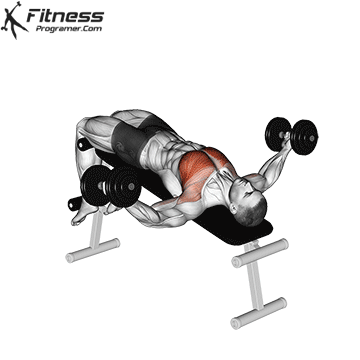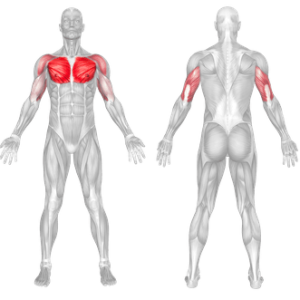Decline Dumbbell Fly Overview
The Decline Dumbbell Fly is a chest isolation exercise performed on a decline bench. This movement targets the lower portion of the pectoral muscles by allowing for a wide range of motion and deep muscle stretch. It emphasizes chest development while also engaging stabilizing muscles to maintain balance and control. This exercise is a great addition to any chest workout routine, especially for those aiming to enhance lower chest definition and symmetry.
How to Perform the Decline Dumbbell Fly

Setup
- Choose a Decline Bench
- Select Appropriate Dumbbells
- Position Yourself: Lie back on the bench with your head lower than your torso and dumbbells in hand.
Execution
- Starting Position
- Hold the dumbbells above your chest with a slight bend in your elbows.
- Palms should face each other, and your arms should be perpendicular to your torso.
- Lowering Phase
- Slowly lower the dumbbells outward in a wide arc, keeping a slight bend in your elbows.
- Lower until you feel a stretch in your chest without going beyond your comfort level.
- Lifting Phase
- Squeeze your chest muscles and bring the dumbbells back to the starting position, maintaining the arc motion.
- Avoid banging the dumbbells together at the top.
- Repeat
- Perform the desired number of repetitions with controlled movements.
Tips for Maximum Effectiveness
- Focus on Form: Maintain a slight bend in your elbows and move in a controlled arc to avoid shoulder strain.
- Engage Your Core: Keep your core tight to stabilize your body on the decline bench.
- Use Moderate Weight: Prioritize technique over heavy lifting to effectively target the chest.
- Squeeze at the Top: Contract your chest muscles at the top of the movement to maximize activation.
- Pair with Compound Exercises: Combine with presses or push-ups for a comprehensive chest workout.
Common Mistakes to Avoid
- Using Excessive Weight: Starting too heavy can compromise form and increase the risk of injury.
- Locking the Elbows: Fully extended arms place unnecessary strain on the elbow joints.
- Lowering Too Deep: Overextending the range of motion can strain the shoulders.
- Rushing the Movement: Performing the exercise too quickly reduces effectiveness and control.
- Incorrect Bench Angle: Using a decline that’s too steep may shift focus away from the chest and onto other muscles.
Benefits of the Decline Dumbbell Fly
- Lower Chest Development
- The decline angle emphasizes the lower portion of the chest, creating a well-rounded, sculpted appearance.
- Enhanced Range of Motion
- Dumbbells allow for a greater stretch at the bottom and a stronger contraction at the top compared to machine-based fly variations.
- Improved Muscle Definition
- Isolates the chest muscles, making it ideal for enhancing chest definition and aesthetics.
- Joint-Friendly Option
- The free-weight motion allows for a natural range of movement, reducing stress on the shoulders and elbows.
- Stabilizer Engagement
- The decline position activates stabilizing muscles, improving overall shoulder stability and balance.
- Corrects Muscle Imbalances
- Each side of the body works independently, helping to correct muscle imbalances and promote symmetry.
- Variation in Training
- Adds variety to your chest routine, preventing plateaus and overuse injuries.
Muscles Worked

